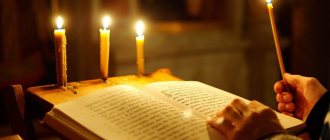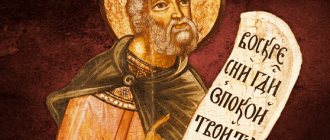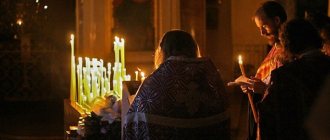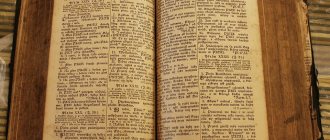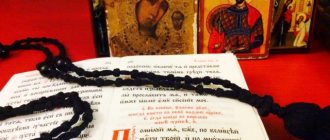Today there is a great increase in interest in the Orthodox faith. And this is probably due to the fact that people began to seek God. After all, life with its sharp turns very often leads them to a real dead end. And then everyone begins their own path to God. In this case, prayer becomes the main companion. She, like a lamp in the darkness, begins to illuminate the path. You just need to learn how to use and understand it correctly. The most powerful liturgical book - the Psalter and Kathisma - will help every believer in this. And if everything is clear with the first concept, then the second causes genuine surprise to many. Accordingly, inexperienced believers are interested in the question: kathisma - what is it? Let's talk about everything in order.
What schedule options are there for reading kathismas?
There are 5 kathisma schedules in total; These schedules are used at various periods of the church year; the order of reading the kathismas is regulated by the 17th chapter of the Typikon. For most of the year, excluding the period of Lent, there are two schedules: they are conventionally called “summer” and “winter”. The summer schedule is used
- from the Week of Antipascha to the celebration of the Exaltation (September 21);
- from the pre-celebration of the Nativity of Christ (December 20) to the celebration of Epiphany (January 14);
- from the Week of the Prodigal Son to the Week of Cheese (for two weeks).
In addition to the three indicated periods, which are given in the Followed Psalter and in the Typikon, in fact, the summer schedule is relevant during the periods of the after-feasts of the twelve feasts, which fall during the periods of validity of the winter schedule. There are only two such holidays and, accordingly, periods: firstly, this is the six-day cycle of the feast of the Entry into the Temple of the Blessed Virgin Mary (November 20–25), secondly, this is the nine-day cycle of the feast of the Presentation of the Lord, if it falls before the Sunday of the Prodigal Son (which happens not every year, although in more than 50% of cases).
The winter schedule is used
- from the celebration of the Exaltation (September 21) to the pre-celebration of the Nativity of Christ (December 20);
- from the celebration of Epiphany (January 14) to the Sunday of the Prodigal Son.
The fundamental differences between the winter schedule and the summer schedule are that at vespers on weekdays the 18th kathisma is read, and at matins on weekdays (Monday, Tuesday, Wednesday, Thursday) three kathismas are read. In fact, the differences between the winter and summer schedules appear only from Monday to Thursday, while on Friday - Sunday they coincide.
What are the rules for reading kathismas during Lent?
During Lent, the reading of kathismas is regulated by three schedules, of which one is the main one; the other two apply only to one week each. During the 1st, 2nd, 3rd, 4th and 6th weeks of Lent there is a special schedule. Its essence is that the Psalter is read twice during the week, which is achieved by reading three kathismas at Matins and reading kathismas at the clock. During the 5th week of Great Lent , a schedule differs from the other weeks. The reason for this is that on Thursday of the 5th week at matins the canon of St. Andrew of Crete is read, as a result of which on this day only one kathisma (8th) is given at matins, and at the 1st hour there is no kathisma at all. Compensation for kathismas missed on Thursday is made by reading an ordinary kathisma at Vespers every day (and not the 18th, as in other weeks). During Holy Week, the Psalter at the same time, a separate 17th kathisma is read with praise at Matins on Holy Saturday.
Excerpt characterizing Kathisma
Having heard the order, this general walked past Pierre, towards the exit from the mound. - To the crossing! – the general said coldly and sternly in response to one of the staff asking where he was going. “And I, and I,” thought Pierre and followed the general in the direction. The general mounted the horse that the Cossack handed to him. Pierre approached his rider, who was holding the horses. Having asked which was quieter, Pierre climbed onto the horse, grabbed the mane, pressed the heels of his outstretched legs to the horse’s belly and, feeling that his glasses were falling off and that he was unable to take his hands off the mane and reins, galloped after the general, exciting the smiles of the staff, from the mound looking at him. The general, whom Pierre was galloping after, went down the mountain, turned sharply to the left, and Pierre, having lost sight of him, galloped into the ranks of the infantry soldiers walking ahead of him. He tried to get out of them, now to the right, now to the left; but everywhere there were soldiers, with equally preoccupied faces, busy with some invisible, but obviously important task. Everyone looked at this fat man in a white hat with the same dissatisfied, questioning look, who for some unknown reason was trampling them with his horse. - Why is he driving in the middle of the battalion! – one shouted at him. Another pushed his horse with the butt, and Pierre, clinging to the bow and barely holding the darting horse, jumped out in front of the soldier, where there was more space. There was a bridge ahead of him, and other soldiers stood at the bridge, shooting. Pierre drove up to them. Without knowing it, Pierre drove to the bridge over Kolocha, which was between Gorki and Borodino and which the French attacked in the first action of the battle (having occupied Borodino). Pierre saw that there was a bridge in front of him and that on both sides of the bridge and in the meadow, in those rows of lying hay that he had noticed yesterday, soldiers were doing something in the smoke; but, despite the incessant shooting that took place in this place, he did not think that this was the battlefield. He did not hear the sounds of bullets screaming from all sides, and shells flying over him, he did not see the enemy who was on the other side of the river, and for a long time he did not see the dead and wounded, although many fell not far from him. With a smile never leaving his face, he looked around him. - Why is this guy driving in front of the line? – someone shouted at him again. “Take it left, take it right,” they shouted to him. Pierre turned to the right and unexpectedly moved in with the adjutant of General Raevsky, whom he knew. This adjutant looked angrily at Pierre, obviously intending to shout at him too, but, recognizing him, nodded his head to him. - How are you here? – he said and galloped on. Pierre, feeling out of place and idle, afraid to interfere with someone again, galloped after the adjutant. - This is here, what? Can I come with you? - he asked. “Now, now,” answered the adjutant and, galloping up to the fat colonel standing in the meadow, he handed him something and then turned to Pierre. - Why did you come here, Count? - he told him with a smile. -Are you all curious? “Yes, yes,” said Pierre. But the adjutant, turning his horse, rode on. “Thank God here,” said the adjutant, “but on Bagration’s left flank there is a terrible heat going on.” - Really? asked Pierre. - Where is this? - Yes, come with me to the mound, we can see from us. “But our battery is still bearable,” said the adjutant. - Well, are you going? “Yes, I’m with you,” said Pierre, looking around him and looking for his guard with his eyes. Here, only for the first time, Pierre saw the wounded, wandering on foot and carried on stretchers. In the same meadow with fragrant rows of hay through which he drove yesterday, across the rows, his head awkwardly turned, one soldier lay motionless with a fallen shako. - Why wasn’t this raised? - Pierre began; but, seeing the stern face of the adjutant, looking back in the same direction, he fell silent. Pierre did not find his guard and, together with his adjutant, drove down the ravine to the Raevsky mound. Pierre's horse lagged behind the adjutant and shook him evenly. “Apparently you’re not used to riding a horse, Count?” – asked the adjutant. “No, nothing, but she’s jumping around a lot,” Pierre said in bewilderment. “Eh!.. yes, she’s wounded,” said the adjutant, “right front, above the knee.” Must be a bullet. Congratulations, Count,” he said, “le bapteme de feu [baptism by fire]. Having driven through the smoke through the sixth corps, behind the artillery, which, pushed forward, was firing, deafening with its shots, they arrived at a small forest. The forest was cool, quiet and smelled of autumn. Pierre and the adjutant dismounted from their horses and entered the mountain on foot. - Is the general here? – asked the adjutant, approaching the mound. “We were there now, let’s go here,” they answered him, pointing to the right. The adjutant looked back at Pierre, as if not knowing what to do with him now. “Don’t worry,” said Pierre. – I’ll go to the mound, okay? - Yes, go, you can see everything from there and it’s not so dangerous. And I'll pick you up. Pierre went to the battery, and the adjutant went further. They did not see each other again, and much later Pierre learned that this adjutant’s arm was torn off that day. The mound that Pierre entered was the famous one (later known among the Russians under the name of the kurgan battery, or Raevsky’s battery, and among the French under the name la grande redoute, la fatale redoute, la redoute du center [the great redoubt, the fatal redoubt, the central redoubt ] a place around which tens of thousands of people were positioned and which the French considered the most important point of the position. This redoubt consisted of a mound on which ditches were dug on three sides. In a place dug in by ditches there were ten firing cannons, protruding into the opening of the ramparts. In line with the mound. there were cannons on both sides, also firing incessantly. A little behind the cannons stood infantry troops. Entering this mound, Pierre did not think that this place, dug in with small ditches, where several cannons stood and fired, was the most important place in the battle. Pierre ", on the contrary, it seemed that this place (precisely because he was on it) was one of the most insignificant places of the battle. Entering the mound, Pierre sat down at the end of the ditch surrounding the battery, and with an unconsciously joyful smile looked at what was happening Around him. From time to time, Pierre still stood up with the same smile and, trying not to disturb the soldiers who were loading and rolling guns, constantly running past him with bags and charges, walked around the battery. The guns from this battery fired continuously one after another, deafening with their sounds and covering the entire area with gunpowder smoke. In contrast to the creepiness that was felt between the infantry soldiers of the cover, here, on the battery, where a small number of people busy with work are white limited, separated from others by a ditch - here one felt the same and common to everyone, as if a family revival. The appearance of the non-military figure of Pierre in a white hat initially struck these people unpleasantly. The soldiers, passing by him, glanced sideways at his figure in surprise and even fear. The senior artillery officer, a tall, long-legged, pockmarked man, as if to watch the action of the last gun, approached Pierre and looked at him curiously.
When and where did the division of the Psalter into 20 kathismas arise?
The modern division of the Psalter into 20 kathismas appeared in Palestine around the 8th century; in the 10th century, this division spread throughout the East due to the fact that the monasteries of Byzantium began to accept the Palestinian practice of daily services. Until the 13th century, this division was used in parallel with the division of the Psalter into 76 antiphons accepted in Constantinople, which was practiced in cathedral worship. After the 13th century (due to the capture of Constantinople by the crusaders in 1204), the cathedral tradition disappeared and the division into 20 kathismas became uncontested.
What can be said about the custom of sitting during kathismas?
In the ancient Church there was no talk of sitting while reading/singing psalms. News from the 6th–8th centuries. both for the East and for the West, they talk about sitting only at readings (edifying), and for the East, standing while singing the entire Psalter at the night service is emphasized: its sections in the well-known description of Sinai Matins are called statiyas, στάσις - standing, and it is said, that they stood up to sing; and these sections (50 psalms each), in terms of their position at Matins, fully correspond to our kathismas. All Studio typikons also require standing behind the kathismas.
The term “kathisma” in relation to sections of the Psalter begins to appear in sources from the 8th–9th centuries; Moreover, for a long time (until the 14th century) the mark “kathisma” was placed at the end of the section of the Psalter, which indicated that sitting was allowed only after reading psalms, during sedals and teachings.
In fact, the modern practice of sitting during kathisma in the Russian Church is a consequence of ignorance of this historical nuance and a literal understanding of the term “kathisma.”
***
Mikhail Skaballanovich. Explanatory typicon:
“Kathisma is a special kind of psalmody, different from psalmody in other places of the church service, for example, from the opening psalms. Namely, the psalms are pronounced here, now mostly read, with the least solemnity and in a calmer body position, sitting. Kathismas are of this nature especially at Matins, where due to this they serve as a rest for the body and soul of those praying from fervent prayers - litanies and from many solemn chants.
We must pray with the opening psalms, for example the sixth psalm, and all others, except the kathisma psalms, and hold ourselves during them “as if conversing with the invisible God,” which is why it is forbidden to sit during them. Through the permission to sit on the kathismas, the psalms are allowed to be listened to not so much as a prayer, but as an edification, as a work of art, to enjoy their poetry to the fullest. At kathismas, therefore, the psalms capture the attention of those praying on the other side in comparison with the psalms of other places of service. Therefore, psalms that have already been sung at the same services in another place are not excluded from the kathismas: all the psalms of the sixth psalm, vespers, and hours are sometimes repeated in the kathismas of these services.
While only a few psalms, 1 or 3, were sung during church services, which took place before the transformation of worship under the influence of monasticism (I-IV centuries), the custom of sitting for psalmody could not arise. It appeared when during services they began to try to chant the entire Psalter in a day or more.
This custom was first mentioned by Cassian in the 5th century. (Intro. ch., 218), and the tone of justification in which he describes this custom of the Egyptian monks testifies to its novelty. News from the 6th–8th centuries. both for the East and for the West, they talk about sitting only at readings (edifying), and for the East, standing while singing the entire Psalter at the night service is emphasized: its sections in the well-known description of Sinai Matins are called statiyas, στάσις - standing, and it is said, that they stood up to sing; and these sections (50 psalms each), in terms of their position at Matins, fully correspond to our kathismas. Standing behind the kathisma is also required by Diatyposis (see below “The Order of Kathisma”; Introductory chapter, 295, 310).
But transferred to the West, perhaps by Cassian, the custom of sitting at the psalms soon became widespread there and transferred to other parts of the service. In the East in the 9th century. there is already the term κάθισμα, which, however, is more applied, as now among the Greeks, to the songs preceding the reading than to the sections of the Psalter, which for the most part are called αϊ στιχολογίαι, and the glory of kathismas - articles, but already in Hypotiposis they are called κάθισμα ψα λμούς , and in Diatyposis and directly κάθισμα. A trace of this practice - sitting only for readings and standing for psalms of kathismas - is also in the current charter: sedals are placed only after those kathismas followed by readings; Thus, sedals are not placed after the kathismas of Vespers, after which there are no readings; on the contrary, sedals are placed without kathismas before the readings, such as, for example, 3 songs of the canon.”
Hymns
The word kathisma
may also refer to a set of troparia (hymns) sung after each kathisma from the Psalter at Matins, which may be preceded by a small ektenia (litany), depending on the typikon in use and a number of aspects of the daily requisites.
In Slavic it is called sedalen
from
sediti
, "to sit" (cf. Latin
sedere
, "to sit").[1]
For clarity, many English translations use the term Sessional Hymns
or
Sedalen
to indicate that these hymns are distinct from the kathisma psalms they follow. Hymns with the same name are also used after the third song of the canon.
